Tensile Properties and Microstructure of Single-Cellulosic Bamboo Fiber Strips after Alkali Treatment
Abstract
1. Introduction
2. Experimental Methods
2.1. Materials
2.2. Fiber Diameter
2.3. Alkaline Treatment
2.4. Fabrication of the Samples
2.5. Fiber Morphology
3. Results and Discussion
3.1. Microstructure Characterization
3.2. Tensile Properties
4. Conclusions
Author Contributions
Funding
Conflicts of Interest
References
- Wang, F.; Zhou, S.; Li, L.; Zhang, X. Changes in the Morphological–Mechanical Properties and Thermal Stability of Bamboo Fibers during the Processing of Alkaline Treatment. Polym. Compos. 2017, 39, 1–8. [Google Scholar] [CrossRef]
- Tran, L.Q.N.; Fuentes, C.; Verpoest, I.; Van Vuure, A.W. others Tensile Behavior of Unidirectional Bamboo/Coir Fiber Hybrid Composites. Fibers 2019, 7, 62. [Google Scholar] [CrossRef]
- Vardhini, K.J.; Murugan, R.; Rathinamoorthy, R. others Effect of alkali treatment on physical properties of banana fibre. Indian J. Fibre Text. Res. 2019, 44, 459–465. [Google Scholar]
- Zubaidah, I.; Norfatriah, A.; Amali, Z.; Noorul, S.; Zuruzi, A.S. Preparation and Behavior of Bamboo Fiber-Reinforced Polydimethylsiloxane Composite Foams during Compression. Fibers 2018, 6, 91. [Google Scholar] [CrossRef]
- Salih, A.A.; Zulkifli, R.; Azhari, C.H. Tensile Properties of Single Cellulosic Bamboo Fiber (Gigantochloa Scortechinii) Using Response Surface Methodology. J. Nat. Fibers 2020, 1–10. [Google Scholar] [CrossRef]
- Singha, A.S.; Thakur, V.K. Fabrication and characterization of H. sabdariffa fiber-reinforced green polymer composites. Polym. Plast. Technol. Eng. 2009, 48, 482–487. [Google Scholar] [CrossRef]
- Salih, A.A.; Zulkifli, R.; Azhari, C.H. Optimization of bamboo mesoparticle/nylon 6 composite mechanical properties using a response surface methodology. Int. J. Mater. Res. 2020, 111, 204–213. [Google Scholar] [CrossRef]
- Salih, A.A.; Zulkifli, R.; Azhari, C.H. Water absorption behaviour and its effect on the mechanical properties of Gigantochloa scortechinii (buluh simantan). Int. J. Microstruct. Mater. Prop. 2019, 14, 184–201. [Google Scholar] [CrossRef]
- Salih, A.A.; Zulkifli, R.; Azhari, C.H. Mechanical and morphological properties of bamboo mesoparticle/nylon 6 composites. Int. J. Mater. Res. 2019, 110, 130–136. [Google Scholar] [CrossRef]
- Bahari, S.A.; Krause, A. Bamboo Particles-Polyvinyl Chloride Composites: Analysis of Particles Size Distribution and Composites Performance. J. Mater. Sci. Res. 2017, 6, 1. [Google Scholar] [CrossRef]
- Gielis, J. Bamboo—The plant and its uses. In The Journal of the American Bamboo Society; Springer: Berlin, Germany, 2015; p. 252. [Google Scholar]
- Kasmuric, M. Engineering Properties and Impact Resistance of Kenaf and Rice Straw Fibres Reinforced Concrete. J. Kejuruter. 2018, 1, 71–76. [Google Scholar]
- Zhang, W.; Yao, X.; Santosh Khanal, S.X. A novel surface treatment for bamboo flour and its effect on the dimensional stability and mechanical properties of high density polyethylene/bamboo flour composites. Constr. Build. Mater. 2018, 186, 1220–1227. [Google Scholar] [CrossRef]
- Ghoushji, M.J.; Eshkoor, R.A.; Zulkifli, R.; Sulong, A.B.; Abdullah, S.; Azhari, C.H. Energy absorption capability of axially compressed woven natural ramie/green epoxy square composite tubes. J. Reinf. Plast. Compos. 2017, 36, 1028–1037. [Google Scholar] [CrossRef]
- Oushabi, A. The pull-out behavior of chemically treated lignocellulosic fibers/polymeric matrix interface (LF/PM): A review. Compos. Part B Eng. 2019, 107059. [Google Scholar] [CrossRef]
- Pappu, A.; Patil, V.; Jain, S.; Mahindrakar, A.; Haque, R.; Thakur, V.K. Advances in industrial prospective of cellulosic macromolecules enriched banana biofibre resources: A review. Int. J. Biol. Macromol. 2015, 79, 449–458. [Google Scholar] [CrossRef]
- Singha, A.S.; Thakur, V.K. Synthesis and characterization of pine needles reinforced RF matrix based biocomposites. J. Chem. 2008, 5, 1055–1062. [Google Scholar] [CrossRef]
- Amel, A.B.; Paridaha, M.T.; Sudin, R.; Anwar, U.M.K.; Ahmed, S.H. Effect of fiber extraction methods on some properties of kenaf bast fiber. Ind. Crops Prod. 2013, 46, 117–123. [Google Scholar] [CrossRef]
- Sugiman, S.; Setyawan, P.D.; Anshari, B. Effects of alkali treatment of bamboo fibre under various conditions on the tensile and flexural properties of bamboo fibre/polystyrene-modified unsaturated polyester composites. J. Eng. Sci. Technol. 2019, 14, 26–46. [Google Scholar]
- Orue, A.; Jauregi, A.; Unsuain, U.; Labidi, J.; Eceiza, A.; Arbelaiz, A. The effect of alkaline and silane treatments on mechanical properties and breakage of sisal fibers and poly (lactic acid)/sisal fiber composites. Compos. Part A Appl. Sci. Manuf. 2016, 84, 186–195. [Google Scholar] [CrossRef]
- Dai, B.; Wang, Q.; Yan, W.; Li, Z.; Guo, W. Synergistic compatibilization and reinforcement of HDPE/wood flour composites. J. Appl. Polym. Sci. 2016, 133. [Google Scholar] [CrossRef]
- Hashim, M.Y.; Amin, A.M.; Marwah, O.M.F.; Othman, M.H.; Yunus, M.R.M.; Huat, N.C. The effect of alkali treatment under various conditions on physical properties of kenaf fiber. In Proceedings of the International Conference on Materials Physics and Mechanics, Langkawi, Malaysia, 23 July 2017; pp. 1–15. [Google Scholar]
- Wong, K.J.; Yousif, B.F.; Low, K.O. The effect of alkali treatment on the interfacial adhesion of bamboo fiber. J. Mater. Des. Appl. 2010, 224, 139–148. [Google Scholar]
- Behera, S.; Prasad, N.; Kumar, S. Study of Mechanical Properties of Bamboo fibers before and after Alkali Treatment. Int. J. Appl. Eng. Res. 2018, 13, 5251–5255. [Google Scholar]
- Essabir, H.; Boujmal, R.; Bensalah, M.O.; Rodrigue, D.; Bouhfid, R.; el kacem Qaiss, A. Mechanical and thermal properties of hybrid composites: Oil-palm fiber/clay reinforced high density polyethylene. Mech. Mater. 2016, 98, 36–43. [Google Scholar] [CrossRef]
- Zhang, K.; Wang, F.; Liang, W.; Wang, Z.; Duan, Z.; Yang, B. Thermal and Mechanical Propertiesrof Bamboo Fibe Reinforced Epoxy Composites. Polymers 2018, 10, 608. [Google Scholar] [CrossRef]
- Chen, H.; Yu, Y.; Zhong, T.; Wu, Y.; Li, Y.; Wu, Z.; Fei, B. Effect of alkali treatment on microstructure and mechanical properties of individual bamboo fibers. Cellulose 2017, 24, 333–347. [Google Scholar] [CrossRef]
- Mishra, S.; Mohanty, A.K.; Drzal, L.T.; Misra, M.; Parija, S.; Nayak, S.K.; Tripathy, S.S. Studies on mechanical performance of biofibre/glass reinforced polyester hybrid composites. Compos. Sci. Technol. 2003, 63, 1377–1385. [Google Scholar] [CrossRef]
- Manalo, A.C.; Wani, E.; Zukarnain, N.A.; Karunasena, W.; Lau, K. Effects of alkali treatment and elevated temperature on the mechanical properties of bamboo fibre—polyester composites. Compos. Part B Eng. 2015, 80, 73–83. [Google Scholar] [CrossRef]
- Liu, Y.; Ma, Y.; Yu, J.; Zhuang, J.; Wu, S.; Tong, J. Development and characterization of alkali treated abaca fiber reinforced friction composites. Compos. Interfaces 2019, 26, 67–82. [Google Scholar] [CrossRef]
- Reddy, K.O.; Shukla, M.; Maheswari, C.U.; Rajulu, A.V. Mechanical and physical characterization of sodium hydroxide treated Borassus fruit fibers. J. For. Res. 2012, 23, 667–674. [Google Scholar] [CrossRef]
- Asim, M.M.; Jawaid, K.A. Effect of Alkali treatments on physical and Mechanical strength of Pineapple leaf fibres. Mater. Sci. Eng. 2018, 290, 1–6. [Google Scholar] [CrossRef]
- Mohan, C.H.K.; Reddy, G.G.V.; Gowda, C.M. Mechanical Properties of Untreated and Alkali Treated Sida Acuta Stem Fibre. Int. J. Sci. Eng. Res. 2015, 6, 1352–1359. [Google Scholar]
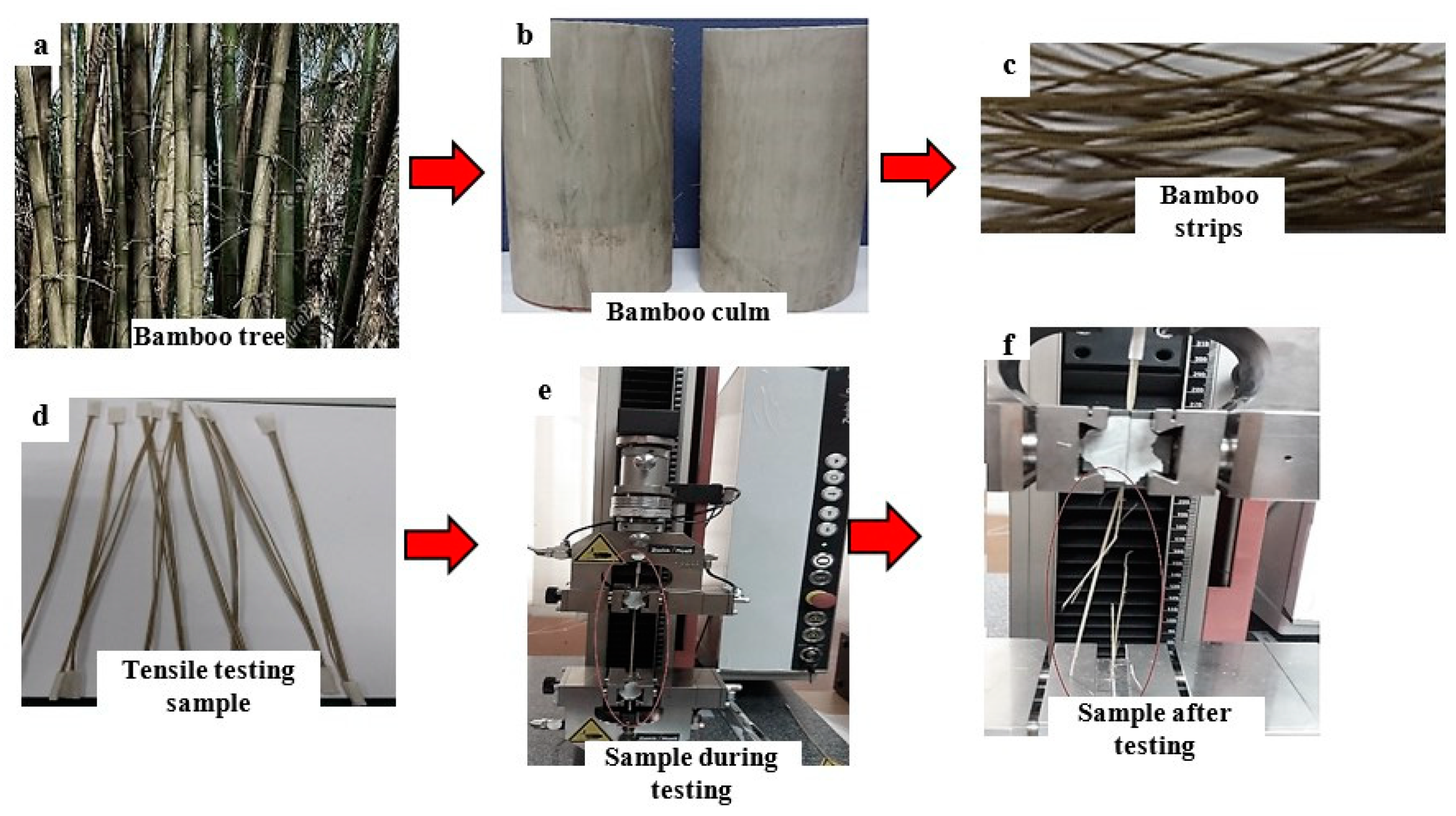



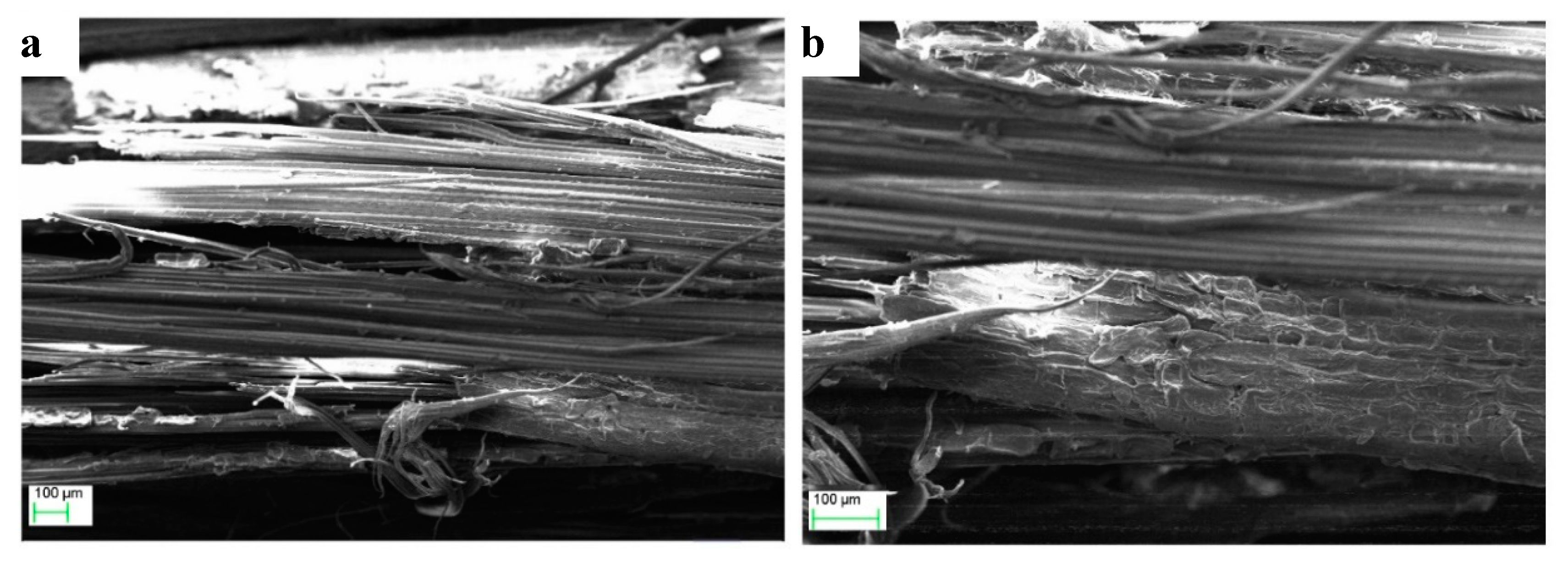
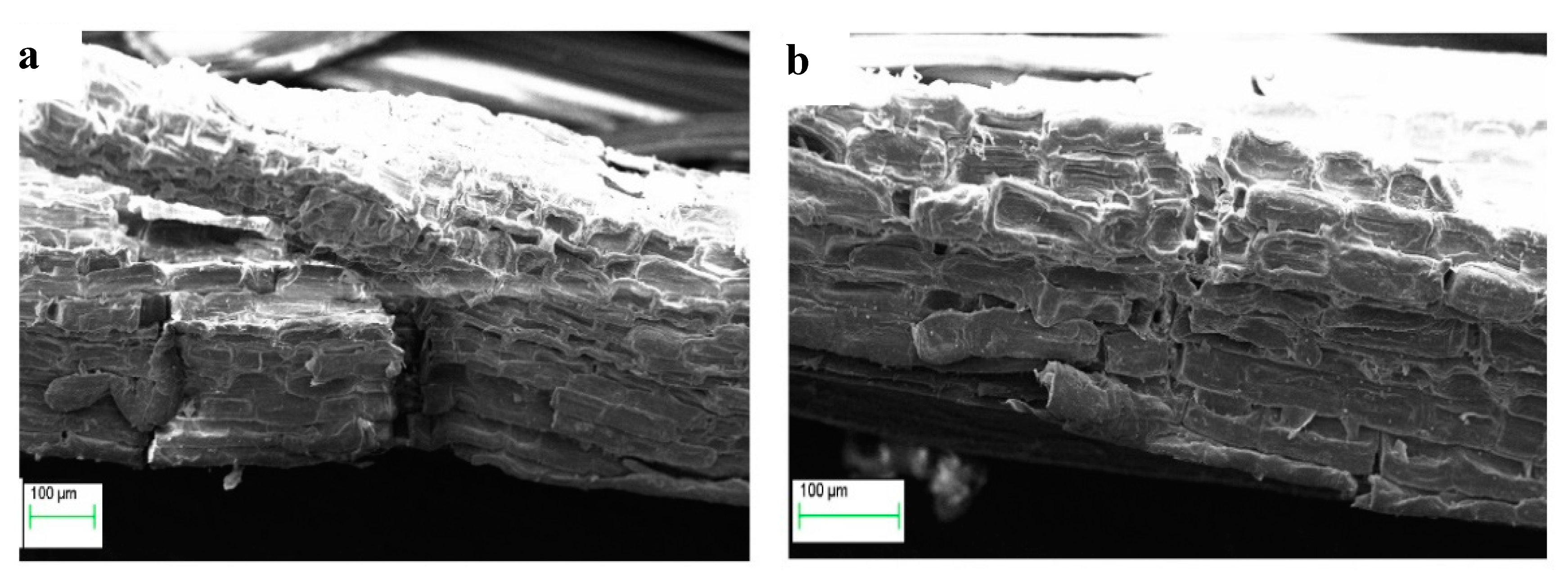
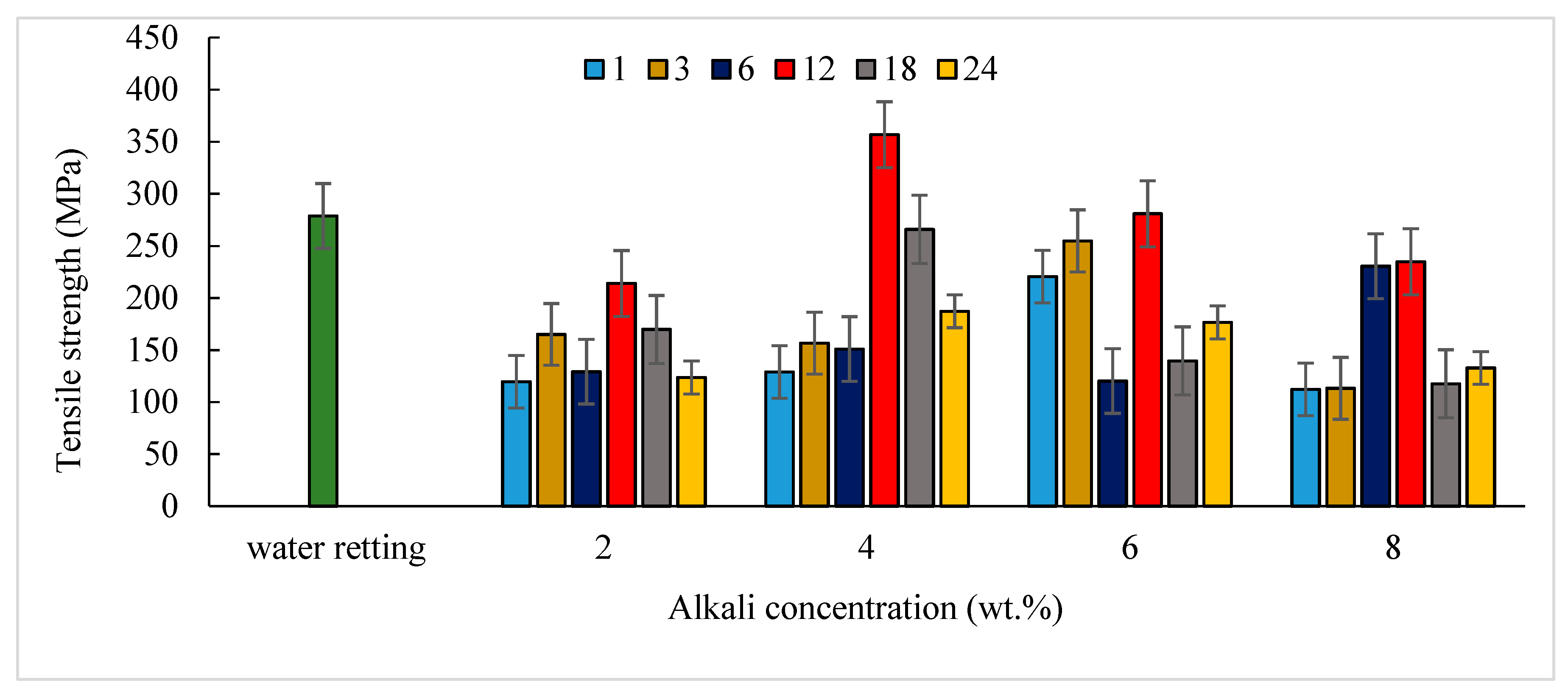

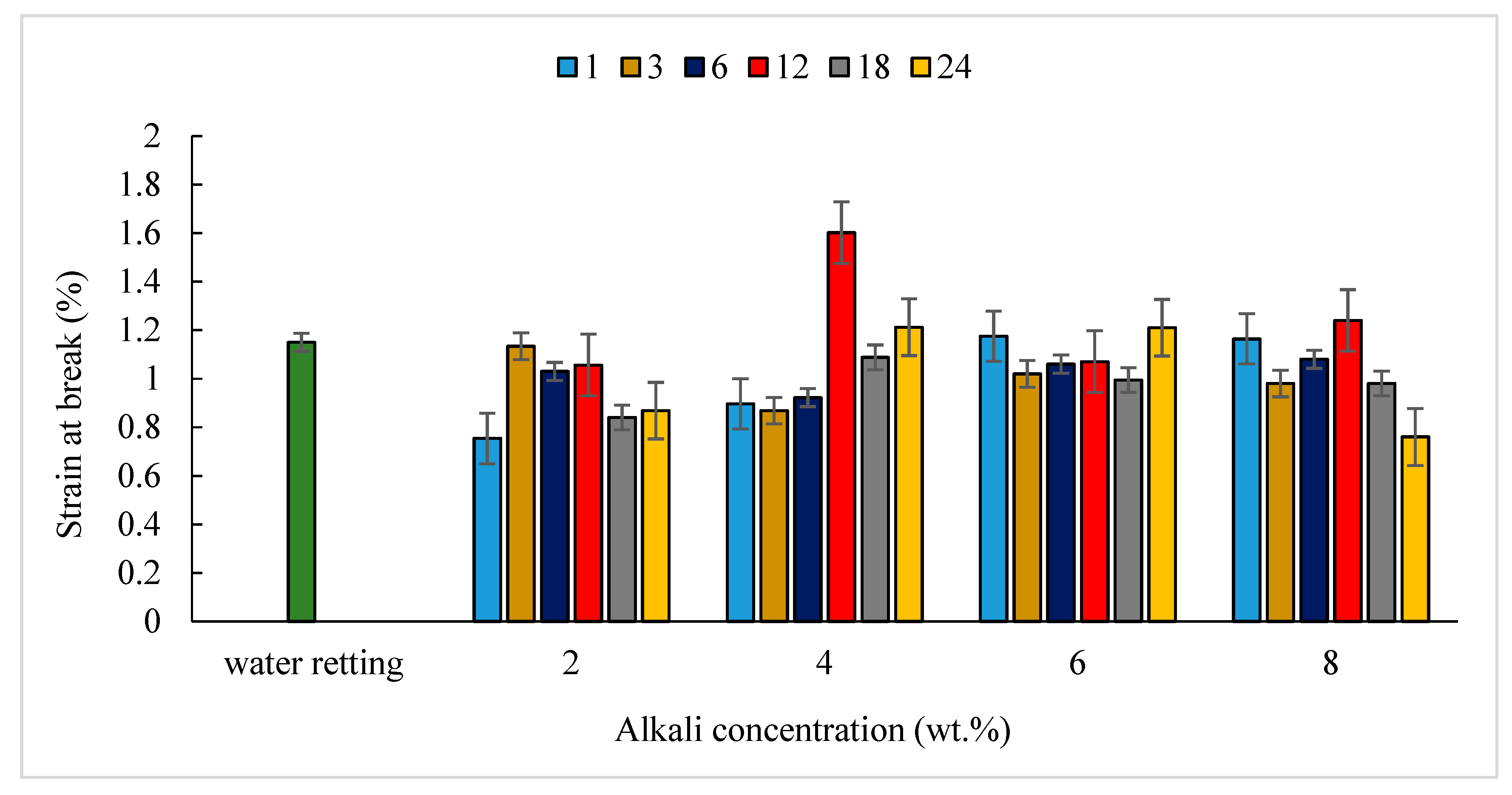
© 2020 by the authors. Licensee MDPI, Basel, Switzerland. This article is an open access article distributed under the terms and conditions of the Creative Commons Attribution (CC BY) license (http://creativecommons.org/licenses/by/4.0/).
Share and Cite
Adel Salih, A.; Zulkifli, R.; Azhari, C.H. Tensile Properties and Microstructure of Single-Cellulosic Bamboo Fiber Strips after Alkali Treatment. Fibers 2020, 8, 26. https://doi.org/10.3390/fib8050026
Adel Salih A, Zulkifli R, Azhari CH. Tensile Properties and Microstructure of Single-Cellulosic Bamboo Fiber Strips after Alkali Treatment. Fibers. 2020; 8(5):26. https://doi.org/10.3390/fib8050026
Chicago/Turabian StyleAdel Salih, Abeer, Rozli Zulkifli, and Che Husna Azhari. 2020. "Tensile Properties and Microstructure of Single-Cellulosic Bamboo Fiber Strips after Alkali Treatment" Fibers 8, no. 5: 26. https://doi.org/10.3390/fib8050026
APA StyleAdel Salih, A., Zulkifli, R., & Azhari, C. H. (2020). Tensile Properties and Microstructure of Single-Cellulosic Bamboo Fiber Strips after Alkali Treatment. Fibers, 8(5), 26. https://doi.org/10.3390/fib8050026




